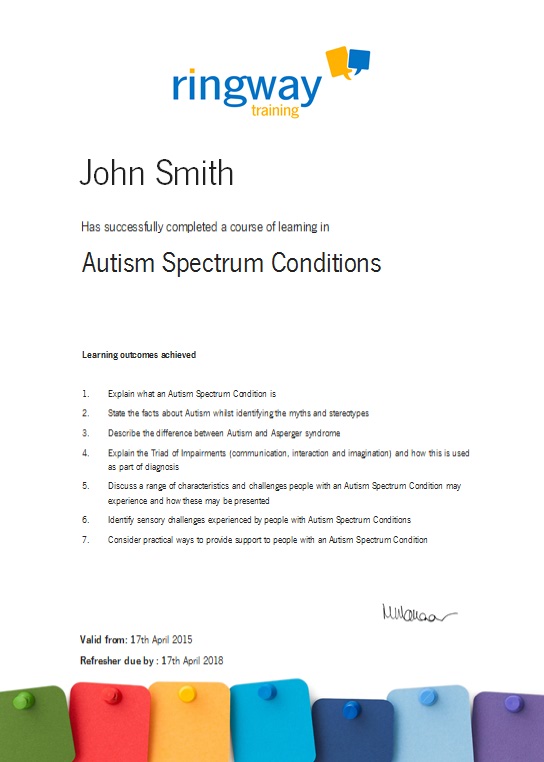Key Info
1 Day Course
Contact us if you require training which runs to a different timescale
Where and When
Delivered at a venue of your choice throughout the UK or by tutor led remote online delivery, contact us for availability.
Accredited Course
The course content are accredited by the Open College Network (OCN) Credit4Learning as a Level 3 course.
Course Overview
Bullying is defined by the Anti-Bullying Alliance as ‘the repetitive, intentional hurting of one person or group by another person or group, where the relationship involves an imbalance of power. It can happen face to face or online’ and is an issue impacting millions of children in the UK including children with extra vulnerabilities including children in care and special educational support.
This training course confirms what bullying is whilst challenging misconceptions, identifies different characteristics which may increase vulnerability in children and considers different methods of bullying.
This training course considers factors which may influence a child to show bullying behaviours including their own potential trauma and previous life experiences and explores ways of supporting children who bully in recognising their own behaviours.
This training course identifies potential indicators which may raise concerns that a child may be being bullied and considers ways of supporting a child who makes an allegation of being bulled (or has been bullied) and the procedure which needs to be followed in raising concerns of suspected or actual bullying incidents. This is a Level 3 accredited course.
Course Learning Outcomes
Below are the main topics covered in this course, expand each one to see the criteria.
- 1.1Define what bullying is
- 1.2Challenge myths associated with bullying
- 1.3Define key ‘objectives’ of children who use bullying behaviour
- 1.4Explain the meaning of an ‘imbalance of power’ which constitutes bullying behaviour
- 1.5Explain the difference between ‘bullying’ and ‘conflict’
- 2.1Explain possible reasons why bullying can occur
- 2.2Describe potential reasons why some children may have increased vulnerability to the risks of bullying
- 3.1Explain different characteristics which may be used as a method of bullying a person
- 3.2Explain different characteristics which may be used as a method of bullying a person
- 3.3Explain different ways in which bullying takes place including; Verbal Bullying, Peer Bullying, In-Direct Bullying, Gang Bullying and Cyber Bullying
- 3.4Describe environments which can increase the risk of bullying occurring
- 4.1Explain different characteristics of bullies including; Aggressive Bullies; Anxious Bullies and Passive Bullies
- 5.1Explain the physical, emotional and psychological impact which bullying can have on a child
- 5.2Describe indicators which may raise concerns that a child is being bullied or has been bullied
- 6.1Describe potential influencing factors which may lead a child into showing bullying behaviours
- 6.2Evaluate ways of working with perpetrators of bullying
- 6.3Describe the importance of rules and boundaries when working with children who bully (or have bullied)
- 6.4Explain the ‘Four A’s Model’ of supporting children to recognise and acknowledge the impact of bullying behaviour
- 7.1Describe ways to respond to allegations of bullying
- 7.2Describe ways of empowering young people to be aware of and to report bullying
- 7.3Describe different ways of supporting people who have been bullied
- 7.4Confirm the importance of a ‘zero-tolerance’ approach to bullying
- 7.5Confirm key policy requirements in responding to suspected or actual bullying incidents
- 7.6Consider proactive approaches to reduce the risk of bullying from happening
Accreditation
The course content are accredited by the Open College Network (OCN) Credit4Learning as a Level 3 course.
Certification
Each learner completing this course will receive an accredited Level 3 certificate of learning.
Additional Information
Training course duration
1 Day (please contact us if you require training which runs to a different timescale).Availability of this training course
This Anti-Bullying Training Course is available as in-house training at a venue of your own choice throughout the UK. Alternatively, also available remotely via a tutor led course over Zoom or MS Teams.Audience for this course
This Anti-Bullying Training Course is designed for professionals who work with children and young people and need to develop their knowledge of recognising bulling, methods of bullying, safeguards and proactive support.QCF Units
This bullying awareness training course is designed to meet the standards outlined in the new Children's Homes (England) Regulations which were introduced on 1st April 2015 and can contribute to outcomes of QCF units including the National Diploma for the Children and Young People's Workforce.Get a Price or more information...
Just fill in this quick form and we will email you an all inclusive price, don't worry we will never add you to any marketing lists - promise. If you want more information first thats great - just get in touch
Clear pricing
We ask for location and approximate numbers because we include any expenses in the quotes we give so you get one clear price
More Information?
If you have any questions, want more information or interested in a series of courses please contact us
Contact Us
